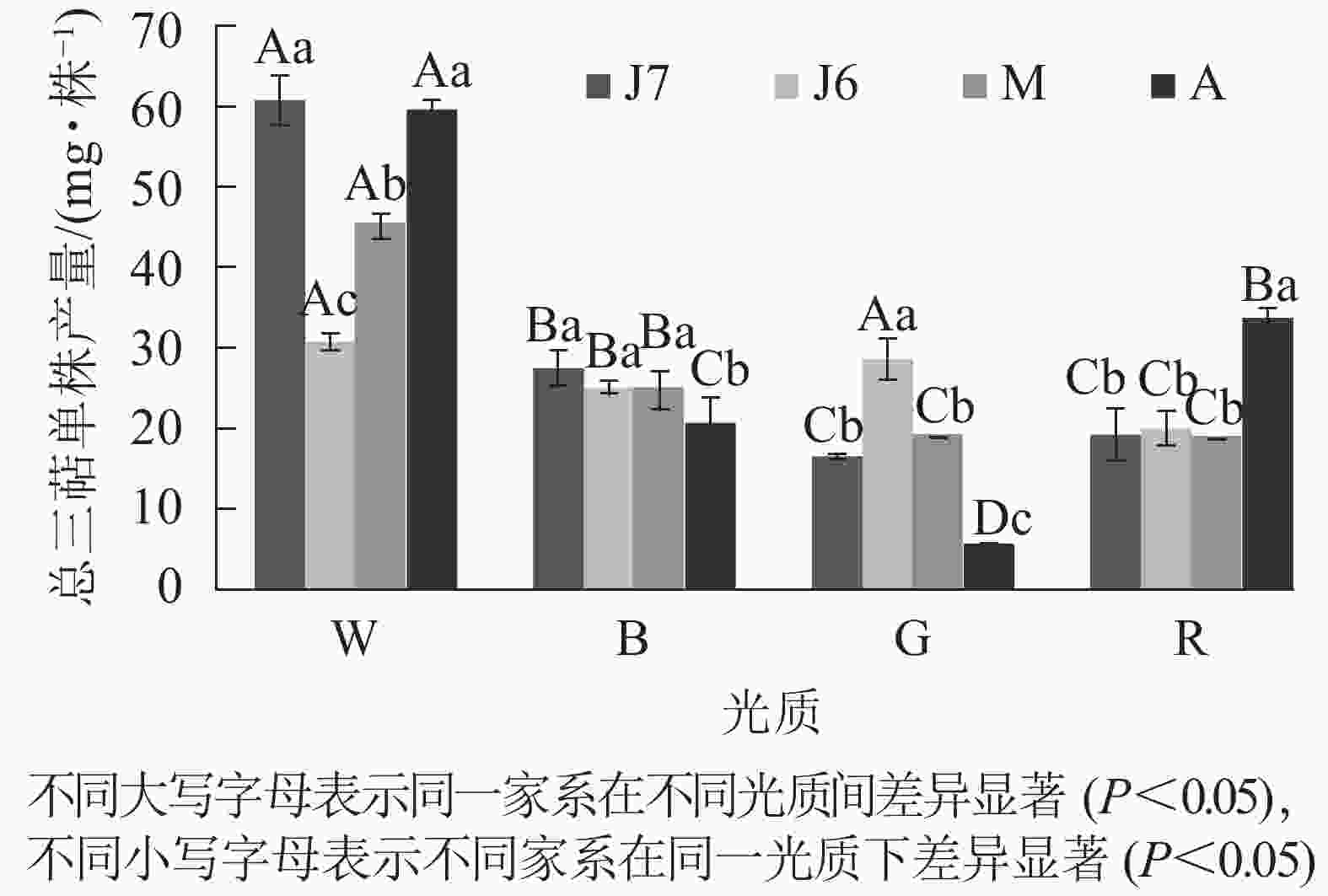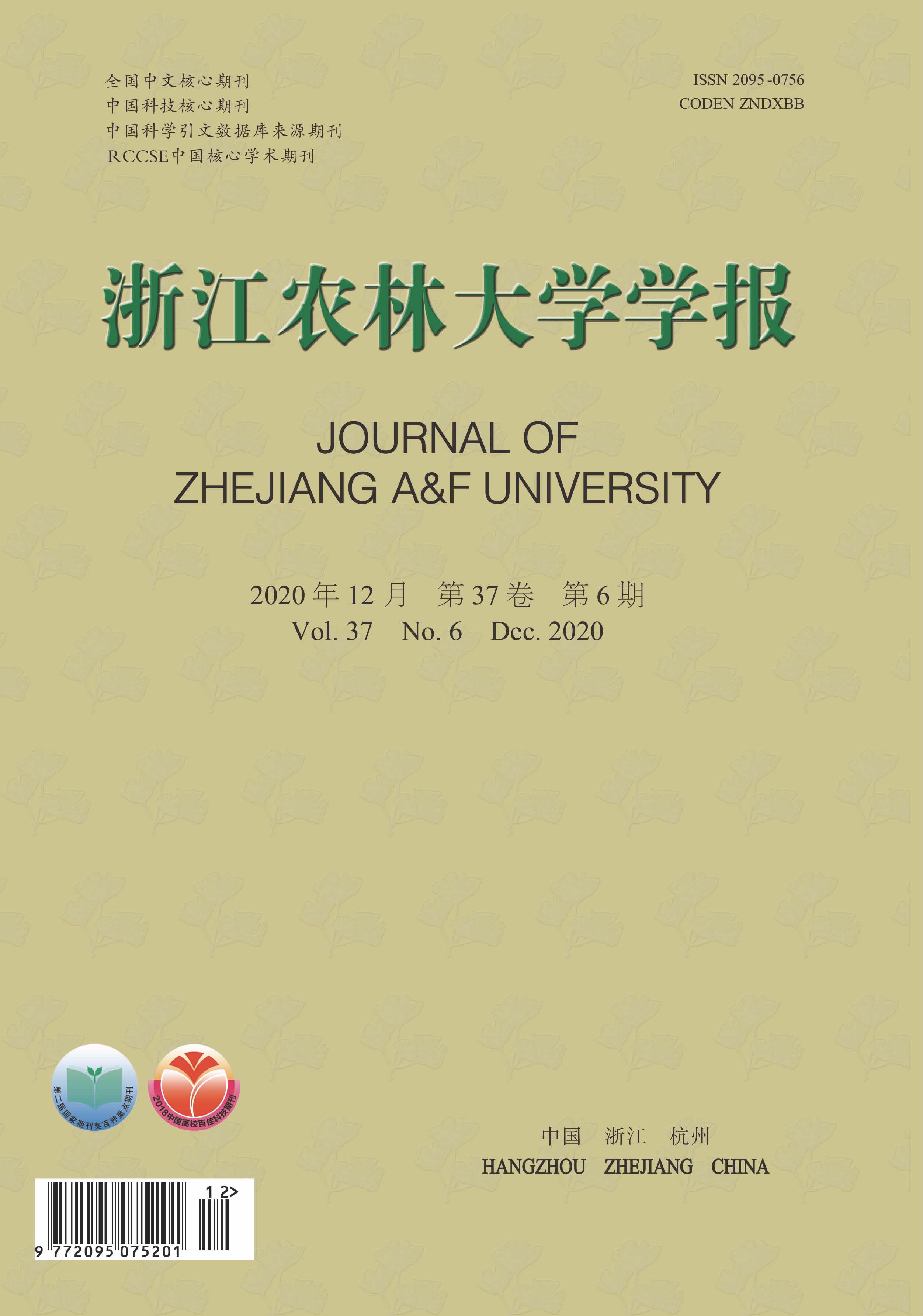-
青钱柳Cyclocarya paliurus又名青钱李、摇钱树、一串钱等,隶属胡桃科Juglandaceae青钱柳属Cyclocarya植物,主要分布于江苏、浙江、贵州、广西、江西等亚热带地区,为特有的单种属多功能树种[1]。研究表明:青钱柳叶中含有多种微量元素和黄酮类、三萜类、多糖类等活性物质,具有降血糖、降血脂、抗氧化和防衰老等功效[2-6],药用开发前景良好。目前,对于青钱柳的研究主要集中于活性物质的提取与分离,而有关遗传因子及环境条件对三萜类化合物积累的影响研究较少[7-8]。遗传因子和环境条件(如水分、温度、光强和光质等)不仅影响植物的生长发育和形态建成,还对植物的次生代谢物质积累产生重大影响[9-12]。掌握光强和光质对植物生长和次生代谢类物质积累影响的规律,不仅有利于提高植物光能利用效率,还有利于实现现代农林业精准高效的生产要求。邓波等[13]发现:遮光、种源及两者的交互作用显著影响了青钱柳总三萜和三萜单体的单株产量。已有研究表明:光质和遗传因子显著影响了青钱柳叶黄酮类化合物的积累[14]。然而,光质条件对青钱柳三萜类化合物积累的影响还不清楚。为了加深遗传因子和光环境对植物三萜类化合物积累影响的认识,本研究开展了光质对不同家系青钱柳生物量积累、叶三萜类化合物质量分数和三萜单株产量影响的研究,以期为药用青钱柳叶用林栽培中的环境调控和选育工作提供参考。
HTML
-
选择4个地域性、生长及活性成分差异显著[14](四川沐川31号、浙江安吉1号、广西金钟山6号、广西金钟山7号)的青钱柳家系种子获得实生幼苗,幼苗在南京市白马教学试验基地培养。2016年5月下旬,选取1年生、生长状况良好、长势一致的青钱柳幼苗(地径约3.0 mm,苗高约36.5 cm)移栽于黄心土∶珍珠岩∶腐熟鸡粪∶草炭(体积比为2∶2∶2∶4)的混合土壤中,选择底部有孔的塑料盆(内径8.5 cm,深10.0 cm),每盆1株。基质的有机质为73.3 g·kg−1,全氮为72.35 g·kg−1,全磷为2.19 g·kg−1,全钾为9.55 g·kg−1,pH为6.44。所有幼苗每日浇水,保持土壤湿润,昼夜温度自然过渡。4周后,待植株长出第4对复叶时(2016年7月初),利用不同颜色LED灯处理:挑选800盆生长健壮且外形较一致的青钱柳幼苗进行光质处理。光质和家系交互试验按照随机区组试验,共16个处理(表1),每个处理5个重复,每个重复10株。实验处理如下:W为对照白光(波段400~690 nm,峰值445 nm/560 nm),R为红光处理(波段600~690 nm,峰值653 nm),G为绿光处理(波段460~597 nm,峰值514 nm),B为蓝光处理(波段400~500 nm,峰值456 nm)。LED光谱特性由NIR-VIS光谱仪(海洋光学,美国)进行测定,各处理下光量子通量控制在(800±50) μmol·m−2·s−1。
处理 光质 家系 处理 光质 家系 WM W(白色LED) M(沐川31) GM G(绿色LED) M(沐川31) WA W(白色LED) A(安吉1) GA G(绿色LED) A(安吉1) WJ6 W(白色LED) J6(金钟山6) GJ6 G(绿色LED) J6(金钟山6) WJ7 W(白色LED) J7(金钟山7) GJ7 G(绿色LED) J7(金钟山7) RM R(红色LED) M(沐川31) BM B(蓝色LED) M(沐川31) RA R(红色LED) A(安吉1) BA B(蓝色LED) A(安吉1) RJ6 R(红色LED) J6(金钟山6) BJ6 B(蓝色LED) J6(金钟山6) RJ7 R(红色LED) J7(金钟山7) BJ7 B(蓝色LED) J7(金钟山7) Table 1. Split-plot randomized design of the experiment
-
处理第80天(观测到显著的生长和形态差异时)测定青钱柳苗高和地径,并从各处理中拔取3株接近其平均值的完整植株测定生物量。先将根冲洗干净,然后用剪刀将根部与地上部分分开,并放在标记好的牛皮纸袋中带回实验室,于105 ℃烘箱中杀青0.5 h,然后80 ℃烘箱内烘干至恒量,称取根部与地上部分干质量。单株总生物量是地上和地下部分生物量干质量之和。
-
将生物量测定完成后的样品研磨成粉末,并密封保存在0~4 ℃冷库。每个处理称取约2 g干样叶片粉末,用滤纸包好后放入250 mL索氏提取器,并用石油醚在70 ℃水浴锅中回流提取4 h,以去除叶样品中极性较小的脂溶性成分。丢弃提取液将药渣在室温下自然晾干,晾干后的药渣作为三萜类提取的样品。本研究采用超声波辅助提取法[15]:用体积分数70%乙醇水溶液在70 ℃水浴下超声提取45 min,在同样条件下提取2次,并将2次提取液合并。合并后的提取液挥发至近干,再以甲醇反复清洗残渣并定容至10 mL作为三萜类质量分数测定的样品。
三萜类化合物单体质量分数用HPLC法进行测定。分析前,所有待测样品原液用0.22 µm有机膜过滤纯化,测定参照CAO等[16]的方法。本研究共检测到6个三萜类次生代谢产物单体(阿江榄仁酸、青钱柳酸B、青钱柳苷B、青钱柳苷A、常春藤皂苷元、齐墩果酸),根据峰面积计算各单体含量。色谱条件:Waters 2695 Alliance高效液相系统、Empower 3数据处理系统、UVD 2996 二极管阵列检测器(DAD)、Waters X-Bridge C18色谱柱(4.6 mm×250.0 mm,5 μm)。流动相为含有0.01%(V/V)甲酸的水溶液(溶液A)和含0.01%(V/V)甲酸的乙腈溶液(溶液B)。梯度洗脱:A溶液与B溶液(V/V)比值:0~13 min为92∶8,13~28 min为81∶19,28~42 min为79∶21,42~60 min为50∶50,60~64 min为55∶45,64~74 min为44∶56,74~90 min为34∶66,90~95 min为15∶85,95~100 min为0∶100。流动相流速为1.0 mL·min−1,柱温为45 ℃,进样量为10.0 μL,检测波长为205 nm。总三萜质量为所检测到的所有三萜单体质量的总和。总三萜(单体)单株产量(mg·株−1)=总三萜(单体)质量分数(mg·g−1)×叶生物量(g·株−1)
-
采用SPSS 17.0分析处理数据。光质和家系对青钱柳生物量及叶三萜类化合物积累的影响及其交互作用采用两因素方差分析,多重比较采用Duncan’s算法。数据为平均值±标准差,用Excel作图。
1.1. 试验材料及试验设计
1.2. 研究方法
1.2.1. 生物量测定
1.2.2. 三萜类化合物测定
1.3. 数据分析
-
不同处理下青钱柳根、茎、叶及总生物量干质量积累的变异范围分别为4.1~7.3、4.3~7.2、4.5~7.7、13.0~21.4 g·株−1(表2)。在白光下生长的青钱柳植株总干质量和茎、叶片干质量最大。方差分析结果表明:光质、家系及两者的交互作用均对青钱柳各部分生物量的积累产生了显著影响(P<0.05)。与白光相比,其他光质处理下的青钱柳总生物量都显著下降(P<0.05);而根、茎及叶生物量的积累在处理间也具有与总生物量相似的变异规律。不同家系青钱柳总生物量的均值在红光、绿光和蓝光下分别降低17.84%、31.46%、4.69%。然而,安吉家系的青钱柳总生物量在蓝光与白光处理间没有显著差异。
处理 生物量/(g·株−1) 根 茎 叶 总生物量 WJ7 6.7 ± 0.1 ab 6.8 ± 0.4 ab 6.5± 0.4 bc 20.0 ± 0.9 abc WJ6 6.2 ± 0.0 bcd 7.2 ± 0.1 a 6.3 ± 0.1 bcd 19.7 ± 0.0 abc WM 6.1 ± 0.3 bcd 7.0 ± 0.1 a 5.6 ± 0.0 cde 18.7 ± 0.2 be WA 6.5 ± 0.2 abc 7.2 ± 0.1 a 7.7 ± 0.4 a 21.4 ± 0.7 a RJ7 5.8 ± 0.1 cde 5.5 ± 0.3 cde 5.9 ± 0.2 be 17.2 ± 0.3 de RJ6 6.4 ± 0.2 bc 5.2 ± 0.6 def 5.5 ± 0.0 de 17.1 ± 0.3 de RM 6.8 ± 0.2 ab 5.3± 0.2 def 5.5 ± 0.1 def 17.6 ± 0.1 de RA 6.4 ± 0.1 bc 5.7 ± 0.2 cd 5.4 ± 0.0 dg 17.5 ± 0.2 de GJ7 4.4 ± 0.5 fg 4.6 ± 0.3 ef 4.6 ± 0.4 g 13.6 ± 1.2 f GJ6 4.1 ± 0.0 g 4.3 ± 0.0 f 4.6 ± 0.3 fg 13.0 ± 0.4 f GM 5.2 ± 0.1 ef 5.9 ± 0.0 bcd 5.9 ± 0.0 be 17.0 ± 0.0 e GA 5.4 ± 0.3 de 4.7 ± 0.1 ef 4.5 ± 0.1 g 14.6 ± 0.1 f BJ7 6.3 ± 0.3 bc 6.4 ± 0.0 abc 6.2 ± 0.0 be 18.9 ± 0.3 bcd BJ6 6.9 ± 0.0 ab 5.5 ± 0.3 cde 5.8 ± 0.1 be 18.2 ± 0.5 cde BM 6.5 ± 0.1 abc 5.5 ± 0.3 cde 5.4 ± 0.2 efg 17.4 ± 0.4 de BA 7.3 ± 0.2 a 6.4 ± 0.2 abc 6.6 ± 0.3 b 20.3 ± 0.3 ab 说明:同列不同字母表示不同处理间差异显著(P<0.05) Table 2. Response of biomass accumulation of C. paliurus from different families to light quality
-
总三萜质量分数在处理间的变异范围为1.2~9.4 mg·g−1,主要的青钱柳三萜单体为齐墩果酸,变异范围为0.4~3.8 mg·g−1(表3)。光质和家系及其交互作用对青钱柳叶三萜单体及其总质量分数的影响都十分显著(表4)。总体来讲,与对照白光相比,单一波段的红光、绿光、蓝光下的青钱柳苷B、青钱柳苷A、常春藤皂苷元、齐墩果酸及总三萜均有所下降(表3),最高质量分数出现在WA、WA、WJ6、WM、WJ7处理;而阿江榄仁酸和青钱柳酸B的最高质量分数分别出现在RJ7和RA处理。不同家系之间的青钱柳叶三萜类化合物的质量分数差异显著(P<0.05)。总体来看,金钟山7号家系的青钱柳叶总三萜质量分数最高(表5)。
处理 叶三萜物质质量分数/(mg·g−1) 阿江榄仁酸 青钱柳酸B 青钱柳苷B 青钱柳苷A 常春藤皂苷元 齐墩果酸 总三萜 WJ7 1.4 ± 0.1 b 0.18 ± 0.00 ef 1.9 ± 0.3 a 2.2 ± 0.0 b 0.05 ± 0.01 h 3.6 ± 0.4 a 9.4 ± 0.1 a WJ6 0.7 ± 0.1 e 0.21 ± 0.02 cde 1.5 ± 0.1 b 0.1 ± 0.0 i 0.57 ± 0.07 a 1.9 ± 0.2 de 4.9 ± 0.6 d WM 1.0 ± 0.0 c 0.21 ± 0.03 cde 2.3 ± 0.1 a 0.2 ± 0.0 h 0.50 ± 0.01 b 3.8 ± 0.0 a 8.0 ± 0.1 b WA 0.5 ± 0.0 f 0.22 ± 0.00 bcd 2.3 ± 0.1 a 3.1 ± 0.1 a 0.06 ± 0.01 h 1.6 ± 0.0 ef 7.8 ± 0.2 b RJ7 1.5 ± 0.1 a 0.19 ± 0.01 def 0.2 ± 0.0 gh 0.1 ± 0.0 i 0.25 ± 0.01 de 1.0 ± 0.1 g 3.3 ± 0.2 e RJ6 0.5 ± 0.0 f 0.24 ± 0.01 bc 1.2 ± 0.1 bcd 0.7 ± 0.0 f 0.07 ± 0.00 gh 0.9 ± 0.2 g 3.6 ± 0.4 e RM 1.1 ± 0.1 c 0.16 ± 0.01 f 0.4 ± 0.0 fgh 1.3 ± 0.1 d 0.12 ± 0.02 fgh 0.4 ± 0.0 h 3.4 ± 0.1 e RA 0.4 ± 0.0 gh 0.28 ± 0.02 a 2.1 ± 0.3 a 3.1 ± 0.1 a 0.06 ± 0.00 h 0.4 ± 0.0 h 6.2 ± 0.3 c GJ7 0.6 ± 0.0 f 0.16 ± 0.01 f 0.6 ± 0.0 efg 0.8 ± 0.1 e 0.29 ± 0.00 d 1.2 ± 0.2 fg 3.6 ± 0.1 e GJ6 0.8 ± 0.0 d 0.17 ± 0.01 f 1.0 ± 0.0 cde 0.2 ± 0.0 h 0.24 ± 0.05 de 3.8 ± 0.3 a 6.2 ± 0.3 c GM 0.2 ± 0.0 j 0.18 ± 0.01 ef 0.2 ± 0.0 gh 0.2 ± 0.0 h 0.15 ± 0.01 f 2.3 ± 0.0 cd 3.2 ± 0.0 e GA 0.1 ± 0.0 j 0.19 ± 0.02 def 0.1 ± 0.0 h 0.4 ± 0.0 g 0.14 ± 0.00 fg 0.4 ± 0.0 h 1.2 ± 0.0 f BJ7 0.4 ± 0.0 gh 0.19 ± 0.02 def 0.5 ± 0.0 fg 1.8 ± 0.0 c 0.36 ± 0.03 c 1.2 ± 0.0 fg 4.4 ± 0.2 d BJ6 0.4 ± 0.0 gh 0.20 ± 0.00 cde 0.8 ± 0.0 def 0.1 ± 0.0 i 0.27 ± 0.01 de 2.6 ± 0.1 bc 4.3 ± 0.1 d BM 0.3 ± 0.0 i 0.20 ± 0.01 cde 0.5 ± 0.0 fg 0.4 ± 0.0 g 0.36 ± 0.03 c 2.7 ± 0.5 b 4.6 ± 0.5 d BA 0.2 ± 0.0 j 0.25 ± 0.03 b 1.3 ± 0.1 bc 0.4 ± 0.0 g 0.23 ± 0.04 e 0.4 ± 0.1 h 3.2 ± 0.3 e 说明:同列不同字母表示不同处理间差异显著(P<0.05) Table 3. Effects of light quality and family on triterpenoid contents in C. paliurus leaves
变异来源 显著水平(P值) 阿江榄仁酸 青钱柳酸B 青钱柳苷B 青钱柳苷A 常春藤皂苷元 齐墩果酸 总三萜 光质 <0.001 <0.001 <0.001 <0.001 <0.001 <0.001 <0.001 家系 <0.001 <0.001 <0.001 <0.001 <0.001 <0.001 0.017 交互作用 <0.001 <0.001 <0.001 <0.001 <0.001 <0.001 <0.001 Table 4. Summary of significance levels for the effects of light quality, family and their interaction on triterpenoid contents of C. paliurus leaves
处理 水平 叶三萜物质质量分数/(mg·g−1) 阿江榄仁酸 青钱柳酸B 青钱柳苷B 青钱柳苷A 常春藤皂苷元 齐墩果酸 总三萜 光质 W 0.90 a 0.21 a 2.0 a 1.4 a 0.30 a 2.7 a 7.5 a R 0.87 a 0.22 a 1.0 b 1.3 b 0.13 c 0.7 c 4.1 b G 0.42 b 0.17 b 0.5 c 0.3 d 0.21 b 1.9 b 3.6 c B 0.40 b 0.20 a 0.8 b 0.7 c 0.31 a 1.8 b 4.1 b 家系 J7 0.97 a 0.18 c 0.8 c 1.2 b 0.24 b 1.8 b 5.2 a J6 0.59 b 0.20 a 1.1 b 0.3 d 0.29 a 2.3 a 4.8 b M 0.63 b 0.19 bc 0.9 c 0.5 c 0.28 a 2.3 a 4.8 b A 0.41 c 0.23 a 1.4 a 1.7 a 0.12 c 0.7 c 4.6 b 说明:同列不同字母表示不同处理间差异显著(P<0.05) Table 5. Effects of different treatments on Duncan’s multiple-range test for triterpenoid contents of C. paliurus leaves
-
在叶片生物量与三萜质量分数的基础上得出了单株三萜类化合物组分的产量,总三萜单株产量的变异范围为5.6~60.7 mg·株−1(图1)。本研究表明:光质和家系及其交互作用显著影响(P<0.05)了总三萜及其单体的单株产量;三萜单株产量的最高值都在白光处理下获得(图1,表6~8)。从家系层面讲,总三萜单株产量最高值从金钟山7号家系获得,安吉1号家系次之(表8,图1)。

Figure 1. Response of total triterpenoid yields in C. paliurus leaves from different families to light quality
处理 叶三萜单体产量/(mg·株−1) 阿江榄仁酸 青钱柳酸B 青钱柳苷B 青钱柳苷A 常春藤皂苷元 齐墩果酸 WJ7 9.1 ± 0.1 a 1.2 ± 0.1 c 12.2 ± 1.0 b 14.5 ± 1.1 c 0.4 ± 0.0 i 23.3 ± 2.0 a WJ6 4.2 ± 0.5 c 1.3 ± 0.1 bc 9.3 ± 0.8 cd 0.6 ± 0.0 hi 3.6 ± 0.4 a 11.8 ± 1.3 c WM 5.6 ± 0.1 b 1.2 ± 0.1 c 12.9 ± 0.5 b 1.3 ± 0.0 hi 2.8 ± 0.0 b 21.3 ± 0.2 a WA 4.2 ± 0.2 c 1.7 ± 0.1 a 17.3 ± 1.5 a 23.6 ± 1.8 a 0.5 ± 0.0 hi 12.3 ± 0.7 c RJ7 8.9 ± 0.9 a 1.1 ± 0.1 cd 1.1 ± 0.1 ij 0.6 ± 0.0 hi 1.5 ± 0.1 ef 6.0 ± 0.5 de RJ6 2.8 ± 0.2 d 1.3 ± 0.1 bc 6.5 ± 0.1 ef 3.8 ± 0.1 f 0.4 ± 0.0 i 5.2 ± 0.0 dg RM 6.0 ± 0.2 b 0.9 ± 0.0 def 2.0 ± 0.1 hij 7.0 ± 0.5 e 0.7 ± 0.0 hi 2.0 ± 0.0 fg RA 2.2 ± 0.2 de 1.5 ± 0.1 ab 11.1 ± 1.6 bc 16.6 ± 0.3 b 0.3 ± 0.0 i 1.9 ± 0.0 fg GJ7 2.6 ± 0.3 d 0.7 ± 0.1 f 2.5 ± 0.2 gj 3.7 ± 0.0 f 1.3 ± 0.1 ef 5.7 ± 0.5 def GJ6 3.8 ± 0.4 c 0.8 ± 0.1 f 4.4 ± 0.3 fgh 1.1 ± 0.0 hi 1.1 ± 0.2 fg 17.4 ± 0.7 b GM 0.9 ± 0.0 f 1.1 ± 0.1 cde 1.4 ± 0.3 ij 1.2 ± 0.1 hi 0.9 ± 0.0 gh 13.3 ± 0.0 c GA 0.6 ± 0.0 f 0.8 ± 0.0 ef 0.3 ± 0.0 j 1.6 ± 0.1 ghi 0.6 ± 0.0 hi 1.7 ± 0.0 g BJ7 2.4 ± 0.1 d 1.2 ± 0.1 c 2.8 ± 0.2 ghi 11.2 ± 0.8 d 2.2 ± 0.2 c 7.6 ± 0.0 d BJ6 2.1 ± 0.1 de 1.1 ± 0.0 c 4.5 ± 0.3 fg 0.4 ± 0.0 i 1.6 ± 0.1 de 15.3 ± 0.7 bc BM 1.5 ± 0.1 e 1.2 ± 0.0 cd 3.3 ± 0.1 ghi 2.0 ± 0.0 gh 2.0 ± 0.3 cd 14.9 ± 1.2 bc BA 3.6 ± 0.2 c 1.6 ± 0.1 a 8.4 ± 0.8 de 2.7 ± 0.3 fg 1.5 ± 0.4 ef 2.8 ± 0.1 efg 说明:同列不同字母表示不同处理间差异显著(P<0.05) Table 6. Effects of light quality and family on yields of individual triterpenoids in C. paliurus leaves
变异来源 显著水平(P值) 阿江榄仁酸 青钱柳酸B 青钱柳苷B 青钱柳苷A 常春藤皂苷元 齐墩果酸 光质 <0.001 <0.001 <0.001 <0.001 <0.001 <0.001 家系 <0.001 <0.001 <0.001 <0.001 <0.001 <0.001 交互作用 <0.001 0.001 <0.001 <0.001 <0.001 <0.001 Table 7. Summary of significance levels for the effects of light quality, family and their interaction on individual triterpenoid yields of C. paliurus leaves
处理 水平 三萜单体单株产量/(mg·株−1) 阿江榄仁酸 青钱柳酸B 青钱柳苷B 青钱柳苷A 常春藤皂苷元 齐墩果酸 光质 W 5.76 a 1.33 a 12.94 a 9.98 a 1.80 a 17.17 a R 4.95 a 1.21 b 5.20 b 6.98 b 0.73 c 3.78 c G 1.96 d 0.85 c 2.16 c 1.90 d 0.98 b 9.52 b B 2.41 c 1.26 ab 4.75 b 4.06 c 1.82 a 10.15 b 家系 J7 5.74 a 1.05 b 4.66 c 7.48 b 1.35 b 10.64 b J6 3.21 b 1.12 b 6.19 b 1.45 d 1.67 a 12.41 a M 3.50 b 1.06 b 4.90 c 2.87 c 1.58 a 12.89 a A 2.63 c 1.42 a 9.29 a 11.13 a 0.73 c 4.68 c 说明:同列不同字母表示不同处理间差异显著(P<0.05) Table 8. Effects of different treatments on Duncan’s multiple-range test for individual triterpenoid yields of C. paliurus leaves
2.1. 光质对不同家系青钱柳生物量积累的影响
2.2. 光质对不同家系青钱柳叶三萜质量分数的影响
2.3. 光质对不同家系青钱柳叶三萜单株产量的影响
-
环境和遗传因子对植物的生长和次生代谢产物如三萜类化合物的积累都有影响[17]。植物体内的光敏色素会感知外界的光质变化,从而影响植物的光合作用、生长发育和形态建成、生理代谢以及结构特征等[18]。本研究表明:白光和蓝光处理下的青钱柳幼苗生长较好,其根、茎、叶生物量和总生物量均高于绿光和红光处理的青钱柳幼苗。考虑到本研究所用的白光LED含有蓝光波段(445 nm),可推测蓝光对青钱柳苗期生长的作用可能大于其他波段的光。这一结果和肉苁蓉Cistanche deserticola、金线莲Anoectochilus roxburghii等植物的光质研究结果较为一致[18-19]。MATLOCK等[20]研究表明:不同地区生长的松香藻Portieria hornemannii主要活性成分卤代单萜烯类(Apakaochtodenes A和B)的含量存在明显差异。李彦等[21]研究表明:光照强度和遗传因子对青钱柳叶的三萜类化合物积累影响十分显著。而梅锡玲等[22]研究发现:不同的LED蓝光、绿光处理有利于灵芝Ganoderma Lucidum菌丝体内总三萜的积累。范桂枝等[23]研究发现:不同光质对白桦Betula platyphylla愈伤组织三萜的积累从大到小依次为蓝光、红光、黄光、绿光,说明蓝光有利于三萜类物质的积累。但本研究结果显示:青钱柳总三萜质量分数在浙江安吉和四川沐川家系的白光处理下最多,蓝光次之,这说明不同植物体内活性组分的积累对环境的响应存在着显著的种属差异。从光质处理的角度分析,三萜类化合物的积累在生长好的白光处理下最高,而在生长差的蓝光和绿光处理下较低;DENG等[7]和李彦等[21]研究也表明:当光照强度降低时,青钱柳的生长会受到抑制,而黄酮类化合物和三萜化合物的积累也明显降低。这一结果和氮素/营养平衡假说[24]较为一致,即当植物生长受到环境(水、光等)胁迫时,以碳为基础的初生生长及次生代谢产物的积累会受到限制。
柯仲成等[25]发现:枇杷Eriobotrya japonica叶中的三萜酸是主要有效活性成分之一,其中熊果酸、科罗索酸和山楂酸具有显著的降血糖、抗炎和抗肿瘤等药理作用。彭艳芳等[26]也发现:山杏Armeniaca sibirica叶中所含有的齐墩果酸、熊果酸和桦木酸也对肿瘤具有非常明显的抑制作用。了解三萜单体酸的药理作用和功能,对于更好、更有针对性地培育获取三萜单体化合物具有重要意义。已有研究表明:青钱柳的降糖降脂及抗氧化功效和其内含的三萜类物质密切相关,尤其是其特有的单体组分如青钱柳酸B、青钱柳苷A和青钱柳苷B等[4]。李新宇等[27]通过对1年生白桦幼树叶片进行不同光质处理发现:绿光可提高齐墩果酸的含量,蓝光可提高白桦酯醇的含量,分别为对照白光的13.280和1.959倍,这与本研究的结果较为一致,蓝光和绿光也有利于青钱柳叶片内部分三萜单体(如齐墩果酸)的积累。对于青钱柳特有的三萜组分(青钱柳酸B、青钱柳苷A和青钱柳苷B)来说,红光处理可能效果更好,但考虑到青钱柳叶三萜产量时,四川沐川家系的白光处理效果较好。










 DownLoad:
DownLoad: